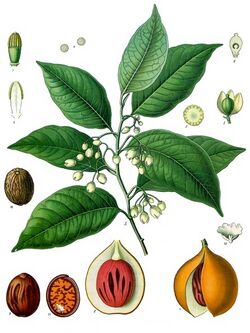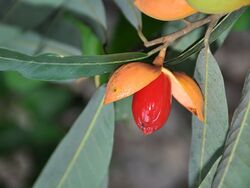Biology:Myristicaceae
| Myristicaceae | |
|---|---|

| |
| Myristica fragrans (Nutmeg), Koehler (1887) | |
| Scientific classification | |
| Kingdom: | Plantae |
| Clade: | Tracheophytes |
| Clade: | Angiosperms |
| Clade: | Magnoliids |
| Order: | Magnoliales |
| Family: | Myristicaceae R.Br.[2] |
| Genera | |
|
See text | |
The Myristicaceae are a family of flowering plants native to Africa, Asia, Pacific islands, and the Americas[3] and has been recognized by most taxonomists. It is sometimes called the "nutmeg family", after its most famous member, Myristica fragrans, the source of the spices nutmeg and mace. The best known genera are Myristica in Asia and Virola in the Neotropics.
The family consists of about 21 genera with about 520 species[4] of trees, shrubs and rarely lianas (Pycnanthus) found in tropical forests around the world. Most of the species are large trees that are valued in the timber industry.


Description
They are typically trees with reddish sap and distinctive pagoda-like growth (known as myristicaceous branching) in which horizontal branching only occurs at certain nodes along the main axis of the trunk, each node separated by a large gap where no branching occurs. All genera are dioecious, except Endocomia and some Iryanthera. The inner bark is usually pink to reddish or light colored then oxidizing as such. When cut, the tree trunk exudes a red or orange resin; stems and young twigs often will exude clear sap (not colored) that may smell spicy. The foliage is generally spicy-aromatic and the leaves are glossy, dark green, simple, entire, 2-ranked, undersides often whitish or tomentose, with dark brown punctations or not, usually with complex caducous hairs colored golden yellow to red. The flowers are usually small, highly reduced, fragrant, with 3-5 tepals, inner perianth whitish-green, yellow, orange, reddish-pink to rusty-brown, arranged in axillary paniculate inflorescences or unbranched wart-like structures (like Knema). The female flowers are without staminodes, with stigmas often lobed. The male flowers with fused stamens arranged in a synandrium. Pollen is monosulcate, often boat-shaped.
The fruit is a leathery dehiscent capsule, with rusty indument or not,[5] containing a single seed that is arillate or not; when present, the aril variously laciniate or entire. In most genera, the aril is colored red but also can be orange or white and translucent. The single seed has ruminate endosperm and is uniform in color or rarely with black blotches (Compsoneura).
Many species within the family exhibit highly complex phytochemistry with numerous compounds having been described from the leaves, bark, fruits, arils, and seeds of many species.
Taxonomy
In the APG IV system of 2016, Myristaceae are placed in the order Magnoliales in the magnoliids clade.[6] The genera placed in the family are related as shown in the following cladogram:[citation needed]
| Myristicaceae |
| ||||||||||||||||||||||||||||||||||||||||||||||||||||||||||||||||||||||||||||||||||||||||||||||||||||||
List of genera
(As of November 2023), Plants of the World Online accepted the following genera:[7]
- Bicuiba J.J.de Wilde
- Brochoneura Warb.
- Coelocaryon Warb.
- Compsoneura (DC.) Warb.
- Doyleanthus Sauquet
- Endocomia W.J.de Wilde
- Gymnacranthera Warb.
- Haematodendron Capuron
- Horsfieldia Willd.
- Iryanthera (A.DC.) Warb.
- Knema Lour.
- Mauloutchia Warb.
- Myristica Gronov.
- Neobrochoneura Figueiredo & Gideon F.Sm.
- Osteophloeum Warb.
- Otoba (DC.) H.Karst.
- Paramyristica W.J.de Wilde
- Pycnanthus Warb.
- Scyphocephalium Warb.
- Staudtia Warb.
- Virola Aubl.
Ecology
Myristicaceae are found in humid lowland forests, swamp forests, submontane forests, and cloud forests at elevations up to 2100 m. Some of the anatomical characters presented by this family suggest that in the past they could live in xeric (dry) environments, but now their species are linked to tropical rainforests.[citation needed]
The species present anthesis at night, and pollination is usually carried out by small beetles from the Anthicidae family that resemble ants and consume pollen (e.g., Myristica fragrans is probably pollinated by the beetle Formicomus braminus).[8] The strong floral scent that attracts beetles emerges from the ends of the connectives of the stamens. However, Myristica is probably pollinated by true ants, a case of myrmecophily.[citation needed]
A few New Guinea Myristica species have evolved hollow stem swellings in which ants reside. This facilitates a mutualistic relationship known as myrmecophily, and is similar to that of Cecropia.[9]
Uses
The most important products of the family by far are the nutmeg and mace spices, both derived from respectively the seed and aril of Myristica fragrans, a tree native to the Moluccas. A hallucinogenic snuff (containing a derivative of tryptamine) that is used by certain Amazonian tribes is obtained from the bark of Virola elongata and other closely related species. The wood of some Asian and American species has local commercial use, as is the case of Otoba parvifolia in South America.
Toxicity
Essential oils of Myristicaceae have antifungal action and antimicrobial activity against Streptococcus mutans.[citation needed] The dark-red resin of the tree bark in some genera, such as Virola, contains several hallucinogenic alkaloids. Myristicin poisoning can induce convulsions, palpitations, nausea, eventual dehydration, and generalized body pain.[citation needed] It is also reputed to be a strong deliriant,[10] and some fatal myristicin poisonings in humans have occurred.[11]
Fossil record
A fossil seed of †Myristicacarpum chandlerae from the early Eocene London Clay flora of southern England is the earliest record of Myristicaceae.[12]
References
- ↑ "Magnoliales". https://www.mobot.org/mobot/research/apweb/orders/magnolialesweb.htm.
- ↑ Angiosperm Phylogeny Group (2009). "An update of the Angiosperm Phylogeny Group classification for the orders and families of flowering plants: APG III" (PDF). Botanical Journal of the Linnean Society 161 (2): 105–121. doi:10.1111/j.1095-8339.2009.00996.x. http://onlinelibrary.wiley.com/doi/10.1046/j.1095-8339.2003.t01-1-00158.x/pdf. Retrieved 2013-07-06.
- ↑ Bingtao Li and Thomas K. Wilson (2008), "Myristicaceae", Flora of China online, 7, http://www.efloras.org/florataxon.aspx?flora_id=2&taxon_id=10596
- ↑ CHRISTENHUSZ, MAARTEN J.M.; BYNG, JAMES W. (2016-05-20). "The number of known plants species in the world and its annual increase". Phytotaxa 261 (3): 201. doi:10.11646/phytotaxa.261.3.1. ISSN 1179-3163.
- ↑ "Myristicaceae in L. Watson and M.J. Dallwitz (1992 onwards) The families of flowering plants". http://delta-intkey.com/angio/www/myristic.htm.
- ↑ Angiosperm Phylogeny Group (2016). "An update of the Angiosperm Phylogeny Group classification for the orders and families of flowering plants: APG IV". Botanical Journal of the Linnean Society 181 (1): 1–20. doi:10.1111/boj.12385. ISSN 0024-4074.
- ↑ Myristiceae R.Br. Plants of the World Online. Retrieved 18 November 2023.
- ↑ Ben Hetzer (2007), Nutmeg: also known as Myristica fragrans, https://bioweb.uwlax.edu/bio203/s2012/hetzer_benj/reproduction%20and%20interactions.htm
- ↑ de Wilde, W.J.J.O. (1995). "Census of Myristica (Myristicaceae) in New Guinea". Blumea 40 (2): 237–344.
- ↑ "Nutmeg". Plants. Erowid. http://www.erowid.org/plants/nutmeg/.
- ↑ Stein, U.; Greyer, H.; Hentschel, H. (2001). "Nutmeg (myristicin) poisoning--report on a fatal case and a series of cases recorded by a poison information centre". Forensic Science International 118 (1): 87–90. doi:10.1016/S0379-0738(00)00369-8. PMID 11343860.
- ↑ Doyle, James A.; Manchester, Steven R.; Sauquet, Hervé (2008), "A Seed Related to Myristicaceae in the Early Eocene of Southern England", Systematic Botany 33 (4): 636–646, doi:10.1600/036364408786500217
External links
Wikidata ☰ Q161214 entry
 |



